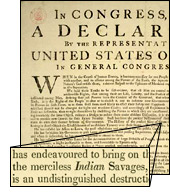By Peter d'Errico
People laud the U.S. Constitution for protecting minorities. If we remember that the Constitution was drafted when slavery was legal and neither women nor men without property could vote, we get a better sense of the “minority” the document was designed to protect. As Charles Beard argued in his 1935 Economic Interpretation of the Constitution of the United States, the framers were primarily interested in protecting their system of wealth. White male property owners were the real minority.
Beard’s view is reinforced by the fact that the Constitutional Convention was galvanized by two property-oriented circumstances. One was the rebellion of farmers and merchants in Western Massachusetts known as Shays’ Rebellion, against banks and courts enforcing mortgages. The other was the lure of Indian lands to be taken for colonization. This combination of threats to the wealthy on one hand and the hope of more wealth on the other was motivation for the framers to propose a central government with power to deal with rebels and Indians.
For more on the subject, see Santorum Blind to America's Sins and Teabaggers Seek White Christian Rule.


No comments:
Post a Comment
Note: Only a member of this blog may post a comment.